
IRIS login | Reed College home Volume 92, No. 2: June 2013
Going through the Fire
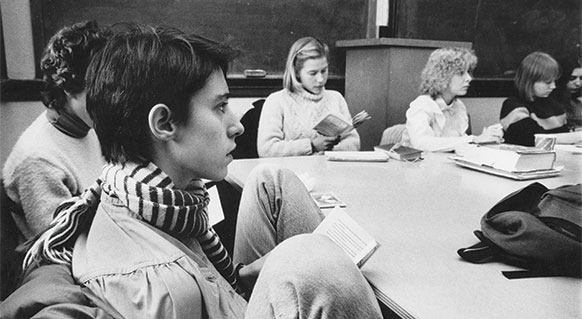
What makes Reed work? The Oral History Project yields some telling clues.
By John Sheehy ’82
Climbing aboard a clutch of logs that he had strung together as a transport raft, Don Wheeler ’35 set off one early fall day in 1931 down the Columbia River from his family’s fruit farm in eastern Washington, bound for Reed College in Portland, Oregon. Known among his high school teachers as “the genius in overalls,” Wheeler was no stranger to the river. By age 16 he had distinguished himself as the only person alive to have successfully traversed the Columbia’s treacherous Priest Rapids. As his raft neared Portland, Wheeler put in ashore and hitchhiked the rest of the way into town on an empty dynamite truck returning from Idaho. Four years later, this genius in overalls found himself hoisted onto the shoulders of fellow Reed students and paraded by torchlight through Portland’s Eastmoreland neighborhood—one of two Reed graduates selected that year for the prestigious Rhodes Scholarship at Oxford University.
Perhaps the most surprising aspect of Wheeler’s metamorphosis from farm boy to hero scholar was its almost commonplace occurrence at Reed. By the time of Wheeler’s graduation in 1935, the college was producing the country’s highest percentage of Rhodes Scholars, as well as the highest percentage of students going on to receive PhDs in the sciences and the second highest percentage in the social sciences. Remarkably, Reed had reached this pinnacle within two decades of first opening its doors in 1911. The question on the mind of educators around the country was, how? What was Reed’s formula for success? The answer to that question lies largely in the singularity of purpose the college chose to pursue at its inception.
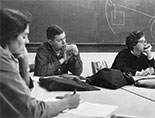
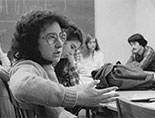
Many alumni interviewed for the Oral History Project said the Reed conference system was a defining experience. Although the two photos shown here were taken 20 years apart (upper, 1962; lower, 1980s), the intellectual atmosphere remained fundamentally unaltered.
“Reed students could not parrot an instructor or memorize a text,” boasted the college’s founding president, William Foster [1910–19]. “If they were to survive, they had to engage in that most painful of all human activities—thinking.”
Foster’s goal was to make critical thinking—thinking about thinking—Reed’s holy grail. While the term “critical thinking” has since become something of a buzzword among liberal arts colleges, at the time of Reed’s founding it was at the forefront of reform efforts in higher education. The antebellum liberal arts college, centered around the Greek idea of cultivating knowledge for the sake of being, had been largely pushed aside by the German research university model, which, with its pursuit of knowledge for the sake of doing, was proving better suited to the market needs of the industrial age. In desperation, many liberal arts colleges had resorted to attracting students with promises of spectator sports, secret societies, and the empty credentialing of the “gentleman’s C.”
Reed launched into this sea of mediocrity with a vision to restore relevancy to the liberal arts through a strict focus on intellectual enthusiasm, combining the traditional emphasis of knowledge for the sake of being with an emerging new American philosophy called pragmatism. Advanced in the late 19th century by the work of Charles Sanders Peirce, William James, and John Dewey, among others, pragmatism’s principal tenet was the skepticism of ideology. Ideas were not to be viewed as immutable truths, but as contingent and provisional responses to the environment—tools that people could utilize in the spirit of scientific inquiry for coping with the world around them. The pragmatists’ skepticism served as a personal safeguard against an increasingly impersonal mass society undergoing the disruptions of rapid industrialization, liberating a rising new generation of progressives with a sense of choice and possibilities in a universe where they viewed themselves able to interact with their environment as agents of their own destinies.
William Foster took the helm of Reed College just two months after receiving his doctorate in education from John Dewey’s Columbia Teacher’s College. His plan was to create a democratic learning community founded on tolerance and equality. It would employ the most rigorous intellectual training possible for the purpose of grinding down the unexamined beliefs and ideologies of students and replacing them with a pragmatic method of thinking. His chief advantage was starting out with a blank slate—Reed was largely unencumbered by the ponderous influence of faculty, alumni, and sectarian tradition that dogged other schools. This allowed him to integrate critical thinking into the three essential promises that college traditionally offers students: personal development, socialization, and achievement.
Different colleges worked these three promises to different purposes. While the majority of schools were geared toward instrumental knowledge and skill training—certifying that a student is intellectually and socially prepared to enter a specific career path in the workforce—for students enrolling at Reed the outcomes were less narrowly defined. They aligned more behind promises of personal enlightenment, empowerment, and self-expression; the creation of intimate relationships of mutual trust and support; and the attainment of broad intellectual preparation for life.
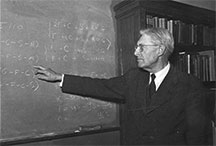
F.L. “Grif” Griffin approached mathematics as a whole language, not just a series of disjointed topics.
“Reed was not fashioned as a savings-bank college where a student would deposit some course credits and then draw out a diploma,” said founding professor F.L. Griffin [mathematics 1911–52], “but as a coherent educational enterprise.”
The purpose of that enterprise was to train students not only to think independently, but to think anew—to master that most difficult maneuver, the intellectual pivot. This required approaching thinking as a free-form and boundless activity. What made this approach relevant is that it provided students with a flexibility of perspective—a deep understanding that “you are not your ideas, but merely a holder of your ideas”—which was critical not only in adapting to the fast-changing modern world, but also in helping shape it.
While Reed’s educational model has evolved over the decades, its essential purpose—thinking about thinking—remains the same as it was that fall day in 1931 when Wheeler set out for college aboard a log raft down the Columbia River. His personal transformation at Reed is echoed in the stories of hundreds of alumni—stories captured in the Reed Oral History Project. Their firsthand accounts reveal a common pattern of intellectual rites of passage that help explain why Reed works.
![]()
Part of the secret to the college’s early success was undoubtedly the unique pool of students it attracted. Many of them were outsiders to private elite colleges of the time, admitted without the barriers of ability to pay, religious affiliation, or gender that limited or restricted admission to other schools. In Reed’s coed, nonsectarian, egalitarian community, students found an environment of broad toleration.
Prior to the 1950s, roughly 80% of them came from the Pacific Northwest. A large number had grown up on ranches and farms, or in small rural towns. Others came from Portland, whose only other college offering until 1938 was a Catholic men’s college. The remainder of the student body was mostly composed of students from the East Coast and California, many of them Jewish students denied admission at other elite colleges because of quota systems, or Unitarians, attracted to Reed by the legacy of its founder, Unitarian minister Thomas Lamb Eliot. What drew many of them to campus was the college’s iconoclastic image.
“In the Portland area,” recalled Mary Barnard ’32, “Reed was looked upon by the young as a school for dreary drudges because there were no Greek-letter fraternities and sororities and no intercollegiate sports. Parents, on the other hand, viewed Reed as extremely dangerous. The rumor persisted that the principal subjects taught at Reed were ‘atheism, communism, and free love.’”
The pejorative slur “atheism, communism, free love” was first directed at the college around the time of the Red Scare in the Pacific Northwest following the First World War. It originated in conservative quarters from critics irritated by the college’s progressive activism, nonsectarian values, and pacifist politics during the 1910s. In a cocky display of nonconformity, students adopted the slur in the 1920s as the college’s tongue-in-cheek motto. It stuck, and for decades functioned, along with Reed’s reputation for academic rigor, like a high birdcall to a certain breed of prospective student.
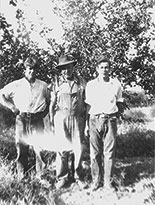
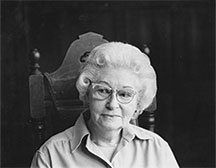
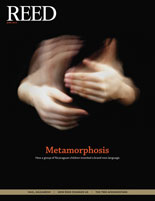
LATEST COMMENTS
steve-jobs-1976 I knew Steve Jobs when he was on the second floor of Quincy. (Fall...
Utnapishtim - 2 weeks ago
Prof. Mason Drukman [political science 1964–70] This is gold, pure gold. God bless, Prof. Drukman.
puredog - 1 month ago
virginia-davis-1965 Such a good friend & compatriot in the day of Satyricon...
czarchasm - 4 months ago
John Peara Baba 1990 John died of a broken heart from losing his mom and then his...
kodachrome - 7 months ago
Carol Sawyer 1962 Who wrote this obit? I'm writing something about Carol Sawyer...
MsLaurie Pepper - 8 months ago
William W. Wissman MAT 1969 ...and THREE sisters. Sabra, the oldest, Mary, the middle, and...
riclf - 10 months ago